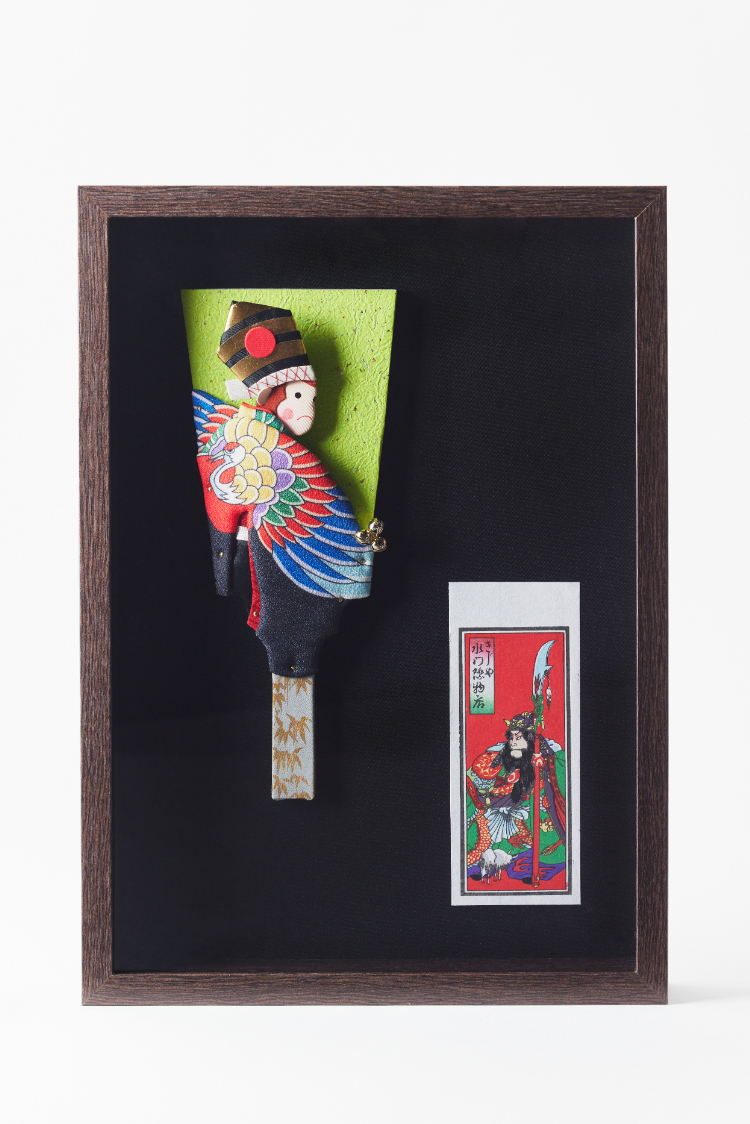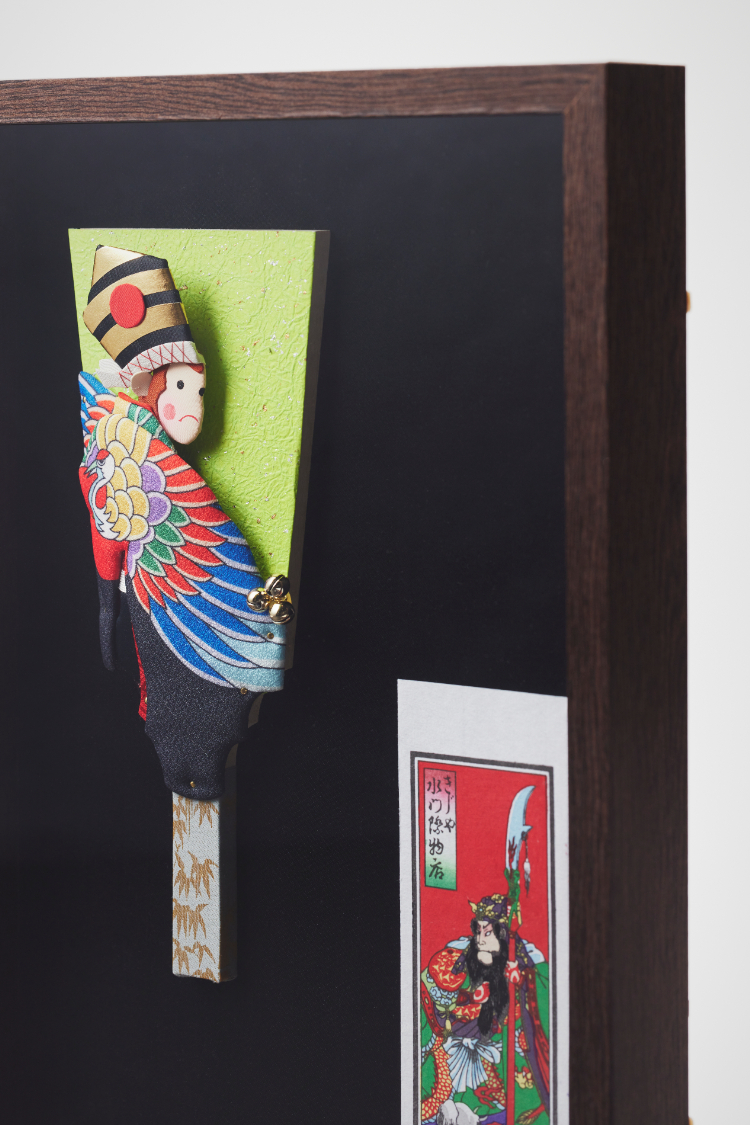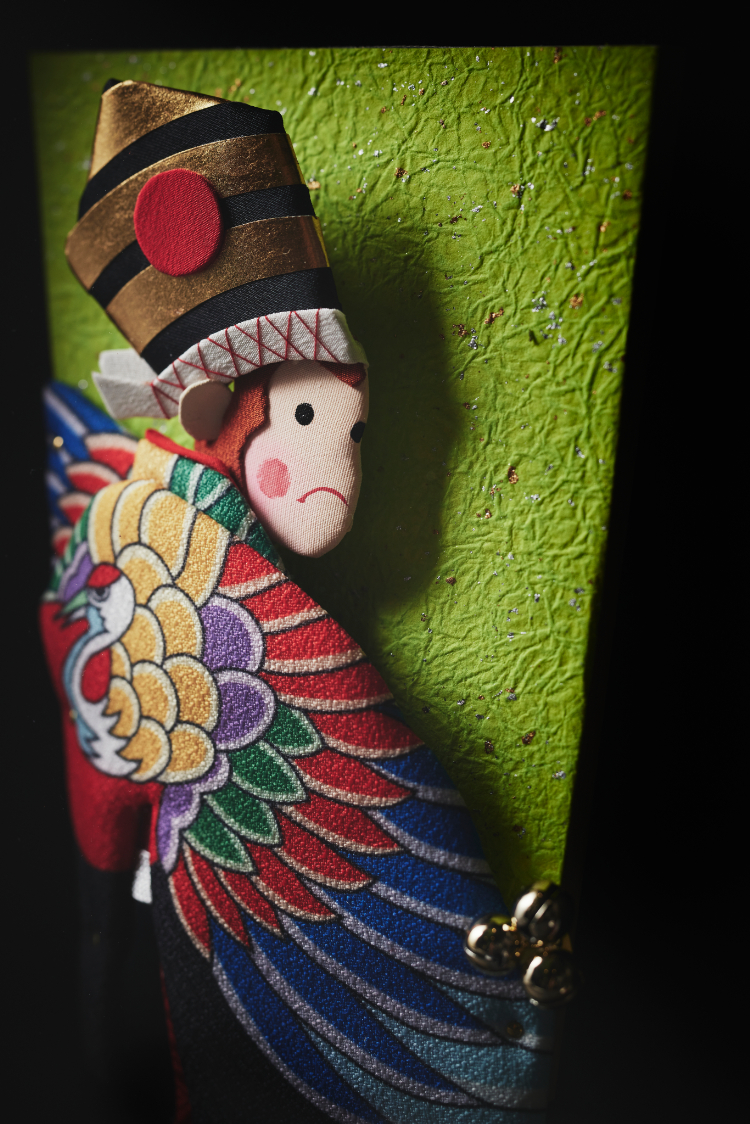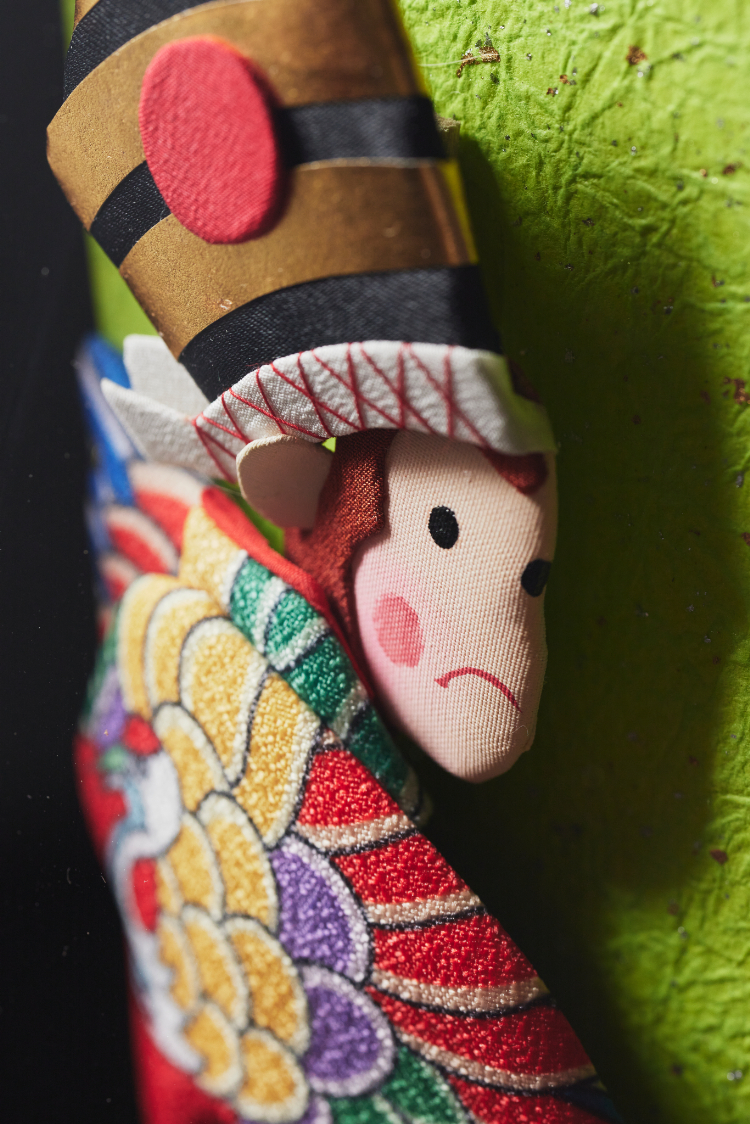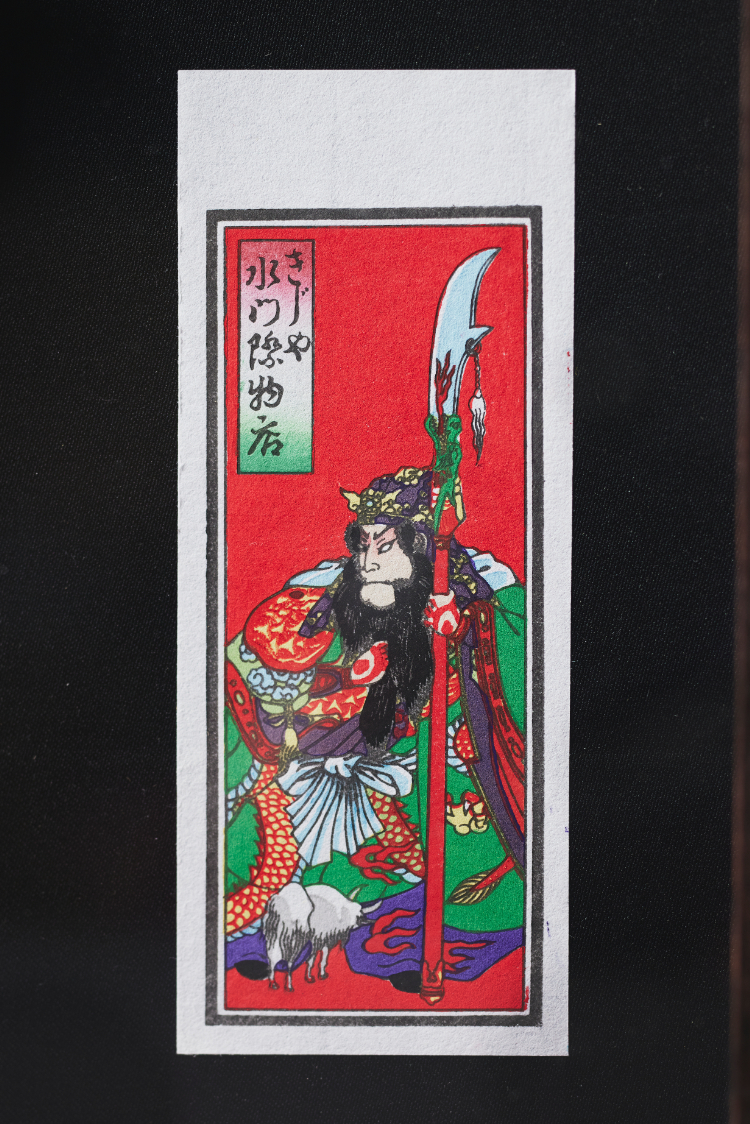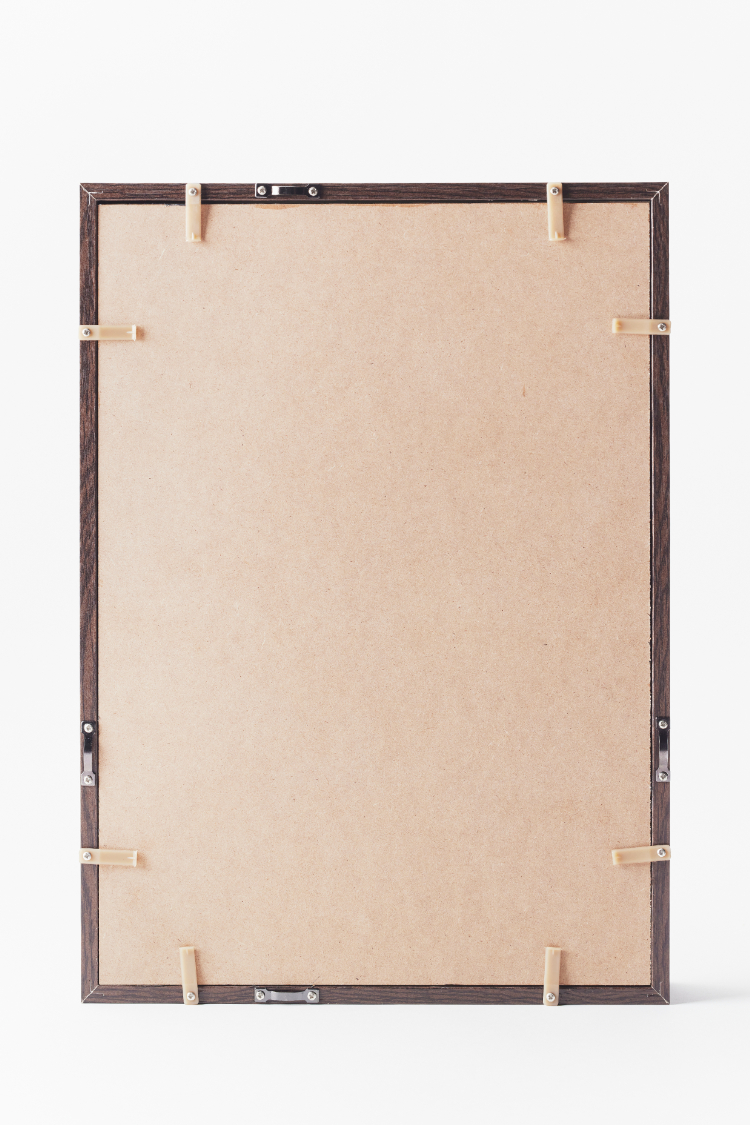Framed Good Luck Battledore “SANBASO”
23 Edo Oshie Hagoita(battledore)Using precious offcuts of silk,
this dynamically created oshie (padded fabric picture)
suggests the feminine modesty of a married lady
in a samurai household,
While the auspicious hagoita battledore,
a springboard for the cool,
evil-dispelling sound of shuttlecock launching heavenward,
In the hands of a craftsman,
is turned into a padded fabric picture featuring a Kabuki actor
in such realism
that the fabric picture seems wholly like a photograph,
such is the hagoita that swept over Edo Japan.
In the classic noh and kabuki performance
known as “Kotobukishiki Sanbaso”,
after the characters Okina and Chitose dance solemnly
in a prayer for peace, the character Sanbaso lightly dances
in prayer for an abundant harvest.
Thus, the hagoita “Sanbaso” is a combination of the auspicious,
adorable Sanbaso depicted on the battledore
and a talisman card depicting the gallant Guan Yu,
who is recognized as both a warrior deity and god of wealth.
The form of the monkey connected with agricultural tasks,
such as ground leveling and planting,
ties into the dispelling of evil.
Wearing an eboshi (courtier’s headgear),
the monkey is dressed in a garment decorated with a crane,
a bird said to live for 1,000 years,
the green background depicting the verdure of spring,
while the jingle bells in the monkey’s hand express
the babbling sound of a clear stream.
In contrast, the red background of this well-known talisman card
signifies the warding off of evil,
the action of which is reinforced by the bearded general (Guan Yu)
in distinctive outfit, holding aloft the green dragon crescent blade
Indeed, Guan Yu’s beard could conceivably be taken to mean a goat,
(the two Chinese characters literally mean “mountain sheep”,
but which is read as goat)
Furthermore,
Guan Yu, a well-received character in the Cao Cao story,
who did not betray Lui Bei (Ryubi),
his much admired lord, is regarded as a man of principle.
And, if the Chinese characters for “sheep” and “self”
are combined into one,
the resulting amalgamation means “principled”.
Hence, people born and raised in Edo associated “sheep”
with Guan Yu.
And the picture talisman card depicting a lamb
that admires a “man of principle” is said to have the power
to ward off evil as well as carry the wish for wealth.
Thus, a combination of the battledore monkey and talisman sheep
creates the Taoist divination of the southwest direction,
referred to as “sheep-monkey” (hitsujisaru)
in the Japanese reading of the relevant Chinese character,
which refers to the rear demon gate,
or the southwest point (in Chinese zodiac terms),
in contrast to the demon gate lying in the northeast position,
known in the sexagenary cycle as ushitora, or cow-tiger.
The demon gate direction (northeast) for Edo Castle
is protected by Senso-ji Temple,
with the more distant Nikko Toshogu Shrine
also providing protection.
Thus, hagoita racquets purchased
at the hagoita fair held at Senso-ji Temple
are thought to bring good luck and ward off evil.
And as if the demon tiles
on the northeast side of the Senso-ji Temple’s shrine
feel bad about scowling at Edo Castle, so, to balance things out,
the southwest side (rear demon gate side)
has sexagenary cycle hitsujisaru monkey tiles looking out.
And it is probably the purported demon-gate protection
provided by this zodiac cycle hitsujisaru monkey
that influenced the custom of monkey protection becoming popular amongst the public.
The skills of excellent artisans
working in a well-established firm dating
back to the Edo period and countless moments of style
and edification recognized by only the discerning,
Come wrapped together with Edo chic in the hagoita set protecting
those who own it from evil
while also carrying a wish of a prayer for prosperity.
- Framed Good Luck Battledore “SANBASO”
- Materials: Frame background: Satin weave (pure silk obi cloth)
Battledore: Paulownia, Picture scroll: Gold brocade damask
Padded cloth picture: Pure silk, rayon, cotton, polyester, foil paper, nickel(bell), cardboard
Padded cloth picture coloring: White pigment, glue, pigment, India ink
Battledore background: Washi (Japanese paper) , gold dust
Print: Washi (Japanese paper) , pigment, Frame: Wood, glass
* The picture is taken with the glass removed for photography.
Size: B4 (H364mm × W257mm) × T35mm
Type: One type only
*The information on this site is as of June 2023.
*Sizes, colours and shapes of the actual products may differ slightly as they are
handmade.
*Product specifications and suggested retail prices may change without prior notice.

